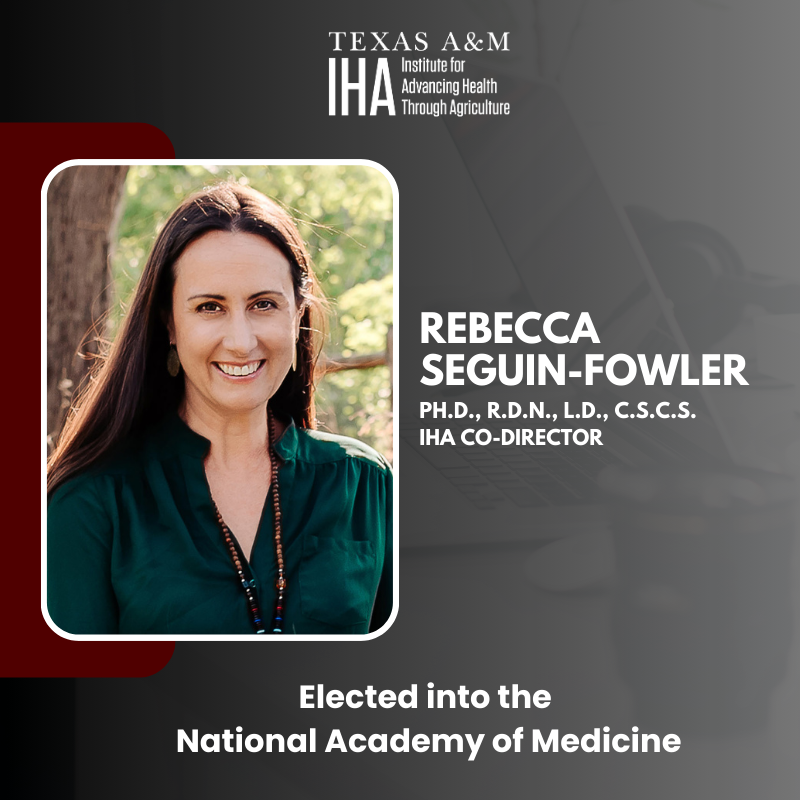Dr. Rebecca Seguin-Fowler’s work in community-engaged health and nutrition research earns invitation for membership in congressionally chartered scientific academy
COLLEGE STATION, TEXAS – October 9, 2023 – Rebecca A. Seguin-Fowler, Ph.D., R.D.N., L.D., C.S.C.S., has been elected to the most prestigious society in the field of nutrition: the National Academy of Medicine. Seguin-Fowler is Co-Director for the Texas A&M Institute for Advancing Health Through Agriculture (IHA) and Professor of Nutrition.
Seguin-Fowler is a leading authority on community-engaged diet and physical activity interventions for obesity and chronic disease prevention among rural, low-income, minority, and other at-risk populations. Her work has advanced knowledge related to social and environmental contextual factors to advance implementation and dissemination research to achieve health equity.

John Sharp, Chancellor of The Texas A&M University System, said he is not surprised the Academy has recognized the important work Seguin-Fowler is doing.
“Dr. Seguin-Fowler’s research exemplifies the kind of public service research the A&M System is proud to support,” Sharp said. “She is now the 57th national academy scholar working at Texas A&M University, the No. 1 public university in Texas, according to The Wall Street Journal.”
Seguin-Fowler is one of four National Academy members who hold leadership capacity within the IHA. Other members include IHA Director Patrick Stover, Ph.D., National Academy of Science, IHA Co-Director Regan Bailey, Ph.D., National Academy of Medicine, and IHA Maternal/Child Cohort Study Scientific Project Director Catharine (Cathy) Ross, Ph.D., National Academy of Medicine.
“Addressing and improving health and nutrition equity among at-risk individuals and communities is among our nation’s most important ongoing priorities,” Seguin-Fowler noted. “With a focus on behavioral theory, health communications, and tailoring interventions to meet the needs of underserved populations and settings, such as low-income families and rural communities, we can secure more equitable healthy living for all. I’m honored to offer my expertise in community and civic engagement intervention and dissemination research in service to the Academy.”
Founded in 1970 as the Institute of Medicine, the National Academy of Medicine is one of three academies to make up the National Academies of Sciences, Engineering, and Medicine (the National Academies) in the United States. Operating under the 1863 Congressional charter of the National Academy of Sciences, the National Academies are private, nonprofit institutions that work outside of government to provide objective advice on matters of science, technology, and health.
In her work at Texas A&M University, Seguin-Fowler spearheads the IHA’s social and behavioral science initiatives via the Healthy Living program. She is also chief scientific officer for Healthy Texas, professor in the Department of Nutrition in the College of Agriculture & Life Sciences, and graduate faculty in the Department of Health Promotion and Community Health Sciences at the School of Public Health.
“Dr. Seguin-Fowler’s continued research on behavioral health and civic engagement is critical to improving the lifestyle and health of underserved communities,” says Dr. Patrick Stover, IHA Director. “Community-engaged research and education, conducted within the appropriate cultural context and in partnership with those living in the communities, is the only solution to leveling the playing field and improving health for all. Dr. Seguin-Fowler’s commitment to this life-changing work is a testament to the infinite potential she holds in service to NAM, to the state of Texas, and to the entire global community.”
“Dr. Seguin-Fowler’s groundbreaking work has not only expanded the boundaries of our understanding but also opened doors to unprecedented possibilities in the field of public health science. Her election to the National Academy of Medicine is a remarkable accomplishment and a testament to the power of relentless pursuit of excellence,” says Dr. Regan Bailey, IHA Co-Director.
Seguin-Fowler has secured more than $15 million in competitive funding to support her research with funding from the U.S. Department of Agriculture, National Institutes of Health, and the Centers for Disease Control and Prevention. She has received numerous awards throughout her career including the 2023 American Public Health Association Award for Excellence, the Mead Johnson Award from the American Society for Nutrition, an Excellence Award from the Society of Behavioral Medicine, and a Career Development Award from the National Institutes of Health National Heart, Lung and Blood Institute. She was also named one of the top 50 women leaders in Austin for 2023. She has published more than 130 peer-reviewed articles and is frequently asked to speak to national and international audiences about her scientific findings as well as her community-engagement research and multisector partnerships.
A registered dietician, Seguin-Fowler received her bachelor’s degree in clinical exercise physiology from Boston University and a master’s degree in nutrition communication and a doctorate in food policy and applied nutrition from Tufts University in Boston.
